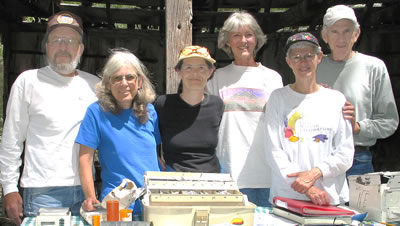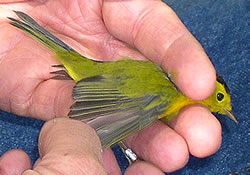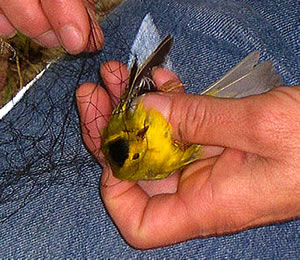Something fascinating happens at the
Matheson Preserve every spring and summer. It’s called
mist netting. Fine nets stretched between two poles create
the illuson of a mist so birds can’t see the nets until
it’s too late.
A day of mist netting at the Matheson Preserve starts before the crack
of dawn because the nets should be up close to sunrise. Getting up so
early discourages most would-be volunteers. Done on a cycle of once every
ten days, the mist netting starts in early May when the weather is still
comfortable. As the season progresses to the end of August, however,
the heat and mosquitoes test dedication to the limit. But for the five
hard-core volunteers, Bob Bailey, Nick and Marian Eason, Carol Hoggard,
and Marcy Hafner, it’s part of an important job. They know that
the information they gather is used to try to reverse the declines in
North American songbirds. It is becoming increasingly apparent that environmental
threats such as climate change, loss of habitat, ozone level depletion,
pollution and the West Nile Virus are affecting the population of birds.
 The
volunteers’ seven to eight hour day starts by putting up ten mist
nets, 39 feet long by 8 feet high, which look like oversized badminton
nets stretched between two ten foot black poles, in different sites around
the south end of the preserve. From a distance the fine netting is barely
visible, and a distracted volunteer could easily walk into it. Designed
to trap small songbirds, each mist net is made up of four tiers of netting
strung up one above the other. When birds fly into the nets, they drop
unharmed into a fold at the bottom of each tier of netting. Checking
the nets every hour, volunteers untangle the birds and gently place them
in a cloth bag. The
volunteers’ seven to eight hour day starts by putting up ten mist
nets, 39 feet long by 8 feet high, which look like oversized badminton
nets stretched between two ten foot black poles, in different sites around
the south end of the preserve. From a distance the fine netting is barely
visible, and a distracted volunteer could easily walk into it. Designed
to trap small songbirds, each mist net is made up of four tiers of netting
strung up one above the other. When birds fly into the nets, they drop
unharmed into a fold at the bottom of each tier of netting. Checking
the nets every hour, volunteers untangle the birds and gently place them
in a cloth bag.
Back at the main station, the first thing to be done is to get a band
on the bird’s leg before it gets away. Some birds are good escape
artists. Then measurements and data are gathered including tests for
West Nile Virus before the bird is released. The Identification Code
to North American Birds by Peter Pyle is the highly detailed, comprehensive
field guide that the group constantly refers to.
Following the guidelines of MAPS (Monitoring Avian Productivity and Survivorship),
the Utah Division of Wildlife Resources with permission ftom the Nature
Conservancy, has run a mist-netting program at the preserve since 1998.
Information from MAPS helps biologists determine whether a particular
species might be declining because fewer birds are hatching or because
more birds are dying. MAPS results are seldom used in isolation but are
incorporated with other research such as the Breeding Bird Survey and
the Christmas Bird Count.
 The
volunteers, most of them recruited from the Moab Bird Club, worked under
the supervision of the Utah Division of Wildlife Resources staff until
last June when due to budget limitations, the volunteers were then asked
to take over the Moab site, thereby freeing state employees to focus
on other banding sites around the state. A daunting undertaking considering
most of the volunteers had limited experience in this field. With just
three weeks of intensive training, they went for it cold turkey. After
their first nerve- wracking morning the volunteers knew they still had
so much to learn. But they also discovered that the only way to really
learn the mist netting program was by getting in there and just plain
doing it. That first successful day built up their confidence that, yes
we can do this. By August, with Bob Bailey, the most experienced, as
their leader and mentor, they had whipped themselves into a smooth working
team. The
volunteers, most of them recruited from the Moab Bird Club, worked under
the supervision of the Utah Division of Wildlife Resources staff until
last June when due to budget limitations, the volunteers were then asked
to take over the Moab site, thereby freeing state employees to focus
on other banding sites around the state. A daunting undertaking considering
most of the volunteers had limited experience in this field. With just
three weeks of intensive training, they went for it cold turkey. After
their first nerve- wracking morning the volunteers knew they still had
so much to learn. But they also discovered that the only way to really
learn the mist netting program was by getting in there and just plain
doing it. That first successful day built up their confidence that, yes
we can do this. By August, with Bob Bailey, the most experienced, as
their leader and mentor, they had whipped themselves into a smooth working
team.
Some mist netting days are busier than others. Between rounds on the
slower days, the group has the luxury of time to grab a snack and exchange
a bit of gossip. This break also gives them the opportunity to study
up especially on the molts (when new feathers replace the old, worn out
ones) which are important for telling the age of the bird.
What do these volunteers like best about the mist netting? Of course,
it’s all about the birds and the excitement of doing, learning,
and seeing birds in the hand. Sometimes, they pick up a rarity. Over
the seasons they’ve banded an ovenbird, worm-eating warbler, northern
waterthrush, summer tanager and a hooded warbler. They also like the
camaraderie of being part of a cohesive, goal-oriented team who know
that what they contribute is invaluable to the long term success for
the survival of bird populations.
The mist netting program is open to the public for observation. Anyone
interested should call the Nature Conservancy at 435-259-4629 for more
information.
|

 The
volunteers’ seven to eight hour day starts by putting up ten mist
nets, 39 feet long by 8 feet high, which look like oversized badminton
nets stretched between two ten foot black poles, in different sites around
the south end of the preserve. From a distance the fine netting is barely
visible, and a distracted volunteer could easily walk into it. Designed
to trap small songbirds, each mist net is made up of four tiers of netting
strung up one above the other. When birds fly into the nets, they drop
unharmed into a fold at the bottom of each tier of netting. Checking
the nets every hour, volunteers untangle the birds and gently place them
in a cloth bag.
The
volunteers’ seven to eight hour day starts by putting up ten mist
nets, 39 feet long by 8 feet high, which look like oversized badminton
nets stretched between two ten foot black poles, in different sites around
the south end of the preserve. From a distance the fine netting is barely
visible, and a distracted volunteer could easily walk into it. Designed
to trap small songbirds, each mist net is made up of four tiers of netting
strung up one above the other. When birds fly into the nets, they drop
unharmed into a fold at the bottom of each tier of netting. Checking
the nets every hour, volunteers untangle the birds and gently place them
in a cloth bag. The
volunteers, most of them recruited from the Moab Bird Club, worked under
the supervision of the Utah Division of Wildlife Resources staff until
last June when due to budget limitations, the volunteers were then asked
to take over the Moab site, thereby freeing state employees to focus
on other banding sites around the state. A daunting undertaking considering
most of the volunteers had limited experience in this field. With just
three weeks of intensive training, they went for it cold turkey. After
their first nerve- wracking morning the volunteers knew they still had
so much to learn. But they also discovered that the only way to really
learn the mist netting program was by getting in there and just plain
doing it. That first successful day built up their confidence that, yes
we can do this. By August, with Bob Bailey, the most experienced, as
their leader and mentor, they had whipped themselves into a smooth working
team.
The
volunteers, most of them recruited from the Moab Bird Club, worked under
the supervision of the Utah Division of Wildlife Resources staff until
last June when due to budget limitations, the volunteers were then asked
to take over the Moab site, thereby freeing state employees to focus
on other banding sites around the state. A daunting undertaking considering
most of the volunteers had limited experience in this field. With just
three weeks of intensive training, they went for it cold turkey. After
their first nerve- wracking morning the volunteers knew they still had
so much to learn. But they also discovered that the only way to really
learn the mist netting program was by getting in there and just plain
doing it. That first successful day built up their confidence that, yes
we can do this. By August, with Bob Bailey, the most experienced, as
their leader and mentor, they had whipped themselves into a smooth working
team.